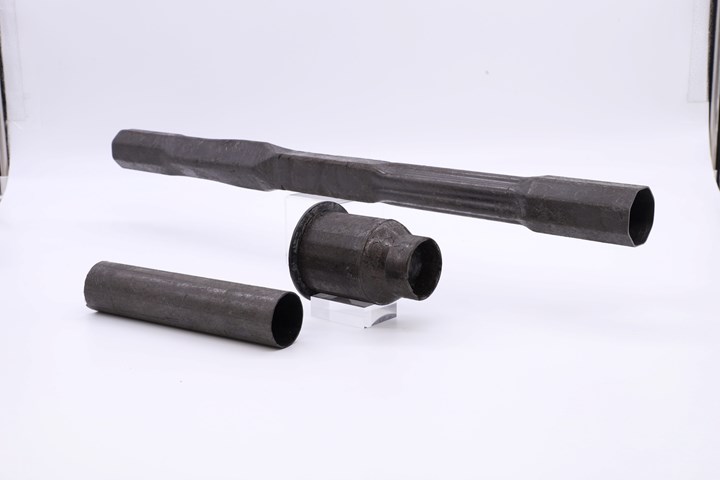Complex recycled CFRTP parts demonstrate discontinuous fiber advantages
CAMX 2023: herone GmbH is showcasing a set of tubes, shafts and profiles, all of which demonstrate the feasibility of rCF discontinuous fibers molded into complex thermoplastic composite parts.
Share
Recycled carbon fiber-reinforced thermoplastic tubes, shafts and profiles. Photo Credit: herone GmbH
Besides herone GmbH’s (Dresden, Germany) standard high-performance thermoplastic and continuous fiber-reinforced hollow profiles, the company is launching a product branch with recycled carbon fibers (rCF), with a focus on complex-shaped parts. Available products are offered with an isotropic fiber architecture and a polyamide 6 (PA6), polyphenylene sulfide (PPS), polyetherimide (PEI) and polyetheretherketone (PEEK) thermoplastic resin matrix.
At CAMX 2023, herone is showcasing a set of different rCF products primarily based on a PPS resin system. They range from tubes and shafts with integral flanges to complex profiles with changing cross-sections along their profile axis. All of the products displayed are molded in one process step from an almost straight preform, demonstrating the advantage of rCF discontinuous fibers to mold complex composite parts.
Herone notes that, due to the discontinuous fiber length of recycled fibers, the performance of the final part may not mirror that of a continuous fiber-reinforced part. Nevertheless, use of discontinuous fibers gives the advantage of molding from less complex semi-finished parts to very complex final shapes, because the discontinuous fibers can “glide” to each other. Consequently, the company notes, composites with recycled fibers can enhance the application field and don’t need to compete (e.g., by price) against the traditional continuous fiber-reinforced composite material applications.
Today’s available semi-finished, hybrid thermoplastic rCF materials are limited in their level of orientation to provide high-performance, load-adapted fiber architectures. Herone has started to develop these materials further for highly orientated rCF pre-impregnated thermoplastic tapes. The company’s aim is to, within the next two year, provide the first rCF hollow part with highly aligned rCF-thermoplastic tapes.
Moreover, herone’s primary UD tape production waste is refurbished into tape chips and can be pressed or injection molded to functional elements, which are combined with the rCF profiles, further achieving zero waste production.
Related Content
-
Cutting supplies, equipment enhance composites testing in the lab
CAMX 2024: On display at Extec’s booth is the Labcut 5000 precision composite plate saw, Nikon MA200 inverted metallurgical microscope and Labpol 12 automatic grinder/polisher.
-
Processing additives achieve improved fiber wetting
CAMX 2023: BYK USA is featuring its BYK-P 9920 solution, particularly well-suited for closed-mold composite applications, as well as other additives for the composites market.
-
Reusable vacuum bagging solutions for composite applications
CAMX 2023: Smartech underscores its industrial reusable vacuum bagging products for reduced waste, easy debulking and the capability to be used for complex projects.




